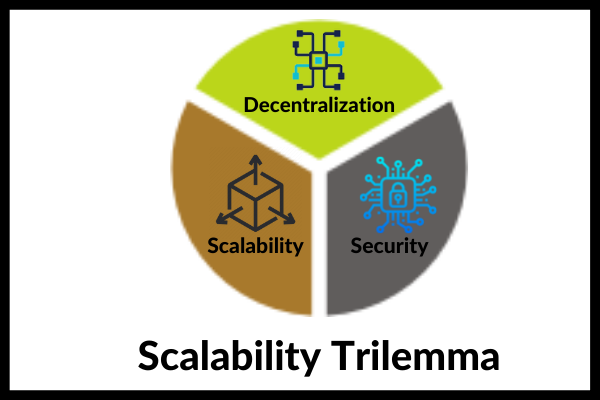Scalability is the key attribute that will propel blockchain potential in the long run.
Many experts have sought to create a lasting solution to blockchain’s scalability limitations.
But can blockchains ever achieve scalability, security, and decentralization, all at the same time? 🤷♀️
In today’s post, we are going to examine this properly by looking at a term dubbed “Scalability Trilemma”.
Let’s dive in!
Post Summary
This is what I will cover:
- Overview Of Blockchain Scalability Trilemma
- Trilemma Trade-Offs In The Blockchain
- Solving The Scalability Trilemma
- Do These Solutions Resolve Scalability Trilemma?
- Conclusion
Read until the end!
Overview Of Blockchain Scalability Trilemma

Scalability Trilemma is a term in the crypto-verse that was popularized by Vitalik Buterin, the founder of Ethereum.
The term is to describe that no single blockchain can possess the 3 desirable components of an ideal blockchain.
The 3 ideal components of blockchain include:
Decentralization
No central authority or middleman should be in full control of the network.
This means that the network’s data validation and consensus should be dispersed among several nodes which can be run by anyone.
It is in fact considered the hallmark of the blockchain, making it permissionless, censorship-resistant, and open-source.
Security
This hinges on three aspects; confidentiality, integrity, and immutability.
A robust blockchain should be resistant to any form of manipulation.
Furthermore, it should be able to verify who the true owner of a transaction is, store it permanently and unchangeably across all nodes, and prevent double-spending.
Scalability
This refers to the blockchain’s capacity in processing a large volume of transactions when compared to the number of users on the network.
A blockchain needs to be scalable for it to achieve mainstream adoption.
Scalability Trilemma states that no blockchain can ever achieve all these three components.
It suggests that tradeoff is an unavoidable part of any blockchain.
Simply put, it argues that a blockchain, depending on its aim and use cases, can only optimize two components while compromising the third.
This is because, according to the notion, improving on all three features at the same time is impossible.
Interestingly, this theory seems to hold, as “tradeoffs” are evident in the blockchain space.
Below, we’ll look at some real-life instances to back up this theory.
Trilemma Trade-Offs In The Blockchain
Decentralization and Security
Bitcoin and Ethereum are examples of blockchain networks that have traded-off scalability.
Each can respectively process 5 and 7 tps. This obviously makes it hard for them to handle a high number of transactions at once.
The reason is that the 2 blockchain uses the POW algorithm, where transactions must be updated across all nodes.
Security and Scalability
To achieve high transaction throughput, blockchains like Ripple, Stellar, and NEO have compromised decentralization.
They can each scale to 50,000, 1000, and 10,000 tps, respectively. They do, however, have centralized consensus mechanisms which are XRP Ledger, SCP, and dBFT.
Scalability and Decentralization
EOS is one of the blockchain networks that fall into this category.
It can process 4,000tps, which is great.
However, it has a partially decentralized consensus mechanism and governance system where the whales may be able to manipulate its network.
Several solutions to the blockchain scalability trilemma have been proposed by the blockchain community.
We will look at some of them below.
Solving The Scalability Trilemma
This will be discussed in this order:
- Layer 1 Solutions
- Layer 2 Solutions
Layer 1 Solutions
They are the solutions that are being implemented directly on the blockchain.
For instance, Ethereum is a blockchain network that is trying to use a POS consensus mechanism and a sharding protocol to address its scalability issues.
We will look at these 2 solutions briefly.
POS Consensus Mechanism
Also called the Proof of stake consensus mechanism.
Here, validators, who are the network’s nodes, confirm transactions by staking their coin on the network.
The number of coins a validator has staked determines his mining power.
Ethereum is currently using the POW as of August 2021 but aims to integrate POS when ETH 2.0 is released.
This is anticipated to improve the Ethereum transaction throughput while also maintaining its decentralization and security.
Sharding
Sharding divides transactions into “shards,” or smaller data chunks.
Well, it does this so that each node will no longer process the entire network’s transactional load.
Anyone can view the data in a shard; however, each node will only store data on its shard.
Also, other blockchains such as Zilliqa, Tezos, and Qtum are looking into using this approach to address the scalability trilemma.
SegWit
This is considered a scalable solution presented to the bitcoin community by Pieter Wuille.
It’s an effort to make a block on the blockchain larger by removing signature data from bitcoin transactions.
The goal is to make bitcoin a scalable, decentralized, and secure network.
Algorand Solution
Algorand is a blockchain that solves Scalability Trilemma by using a PPOS consensus mechanism.
PPOS stands for Pure Proof of Stake.
It is a consensus mechanism similar to Proof of Stake.
In PPOS, token holders need to stake their coins to validate transactions.
Also, validators’ mining power is determined by the number of tokens they stake on the network.
The difference, however, is that the algorithm selects validators regardless of their stake.
Pure proof of stake offers an egalitarian consensus mechanism over POS.
This is because it allows everyone in the network to validate transactions, rather than only the whales.
Learn more about Algorand here.
Layer 2 Solutions
Unlike layer 1, these are scaling solutions that are built outside the blockchain.
I will be discussing 2 here.
Lightning network
The Lightning network aims to increase blockchain’s scalability by allowing off-chain payment processing.
It allows anyone to set up a payment channel with a payment partner using a multisig wallet.
The two partners can interact numerous times, but only the transaction that occurs when the payment channel is opened and closed is recorded on the blockchain.
One other advantage is that these two partners can use the network’s payment router to swiftly send transactions to many other people.
Although this solution was first presented by the bitcoin community, it has been adopted as what we call state channels into other blockchains.
We discussed the Lightning network in detail here.
Sidechains
Sidechain is a scaling solution that brings interoperability between 2 separate blockchain networks.
It allows anyone to transfer and use coins from one blockchain to another blockchain.
Meanwhile, they can send the coins back to their original blockchain securely.
It basically consists of the Mainchain and a Sidechain.
The idea is that you transfer your coins from the Mainchain to the sidechain for interoperability to happen.
Furthermore, the sidechain is linked to the Mainchain using a mechanism known as a “2-way peg,” which is basically a network bridge.
More so, since the Sidechain is a different blockchain, it is not required to use the same consensus mechanism as the Mainchain.
I’ve included some examples below to help you visualize the notion of Sidechains.
- Polygon a popular blockchain is one of Ethereum’s sidechains.
- Wrapped tokens are yet another form of coins designed to facilitate sidechain transactions
After reviewing all of these solutions, one issue remains: Do these solutions address the blockchain’s Trilemma?
Let’s get to the next section where I discussed this in detail.
Do These Solutions Resolve Scalability Trilemma?
Truly, the solutions that are given here address scalability issues with blockchains.
However, they do not solve the scalability trilemma.
Each solution, of course, has a tradeoff!
To get to the heart of the matter, I’ll go over each of them one by one.
- Proof-of -stake is partially decentralized since the network can be controlled by whales
- Sharding has a security vulnerablility known as “Shard takeovers”, also it limits all participants in the network to verify transaction
- Segwit is not the ultimate solution to scalability. It does not have a long term potential, since the bitcoin block time still remains constant
- Despite its great concept, Algorand’s consensus algorithm may be considered censorship resistant since not every network participant is allowed to validate transactions.
- Lightning network compromises decentralization, according to this study. It relies on centralized hub for payment routing and it is also not transparent since certain transactions are not updated on the blockchain.
- Decentralization is sacrificed while using a sidechain. This is due to the fact that it employs a concept known as “locking and realising coins,” which is essentially controlled by an intermediary known as “Federation.”
As you can see, none of these solutions has been able to solve the scalability trilemma.
You are still here? Good.
We’ll get to the end of this post if you scroll down.

Do you want to learn how to trade cryptocurrencies profitably?
We developed a perfect course to help you master Cryptocurrency Trading.
Go to www.ctmastery.com to enrol.
You can also join our Telegram community at https://t.me/ctmastery for more information.
Conclusion
Here is where we will wrap up today’s post.
Although the blockchain community has proposed several solutions, none has completely refuted the scalability Trilemma issue on the blockchain.
However, further ideas or mechanisms for resolving this trilemma are still under consideration.
But the question is:
Is Scalability Trilemma ever going to be resolved, and how near are we to finding a long-term solution?
Should we accept the trilemma as a blockchain flaw and opt for which is the better tradeoff instead?
Well, I am leaving this open for your comment.
Which of the solutions do you think is near to solving the blockchain scalability trilemma?
In your opinion, which feature is compromisable?
Put down your thoughts in the comment section below.
To share this post with a larger audience, use the share buttons below.
Simply click on your preferred social media icon and you’re done.
Also Read:



0 Comments